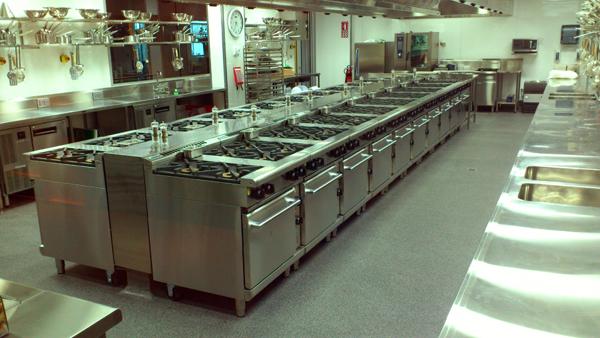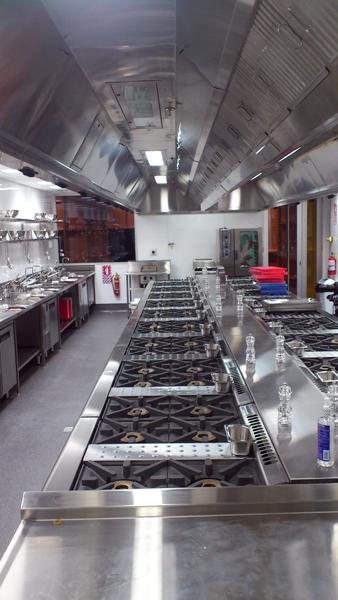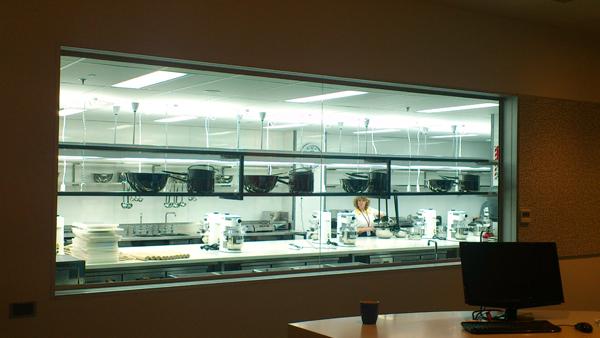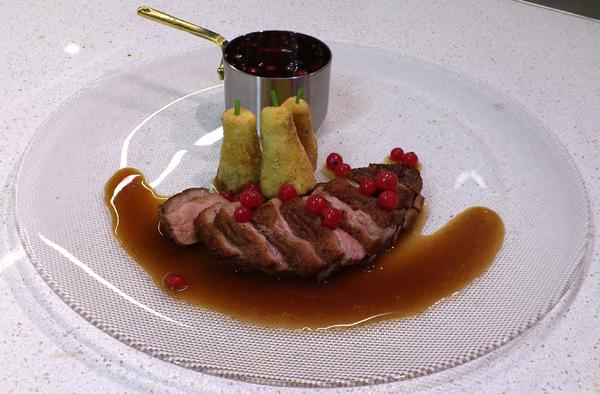-
Posts
1,664 -
Joined
-
Last visited
Content Type
Profiles
Forums
Store
Help Articles
Everything posted by lesliec
-

Le Cordon Bleu comes to town
lesliec replied to a topic in Australia & New Zealand: Cooking & Baking
I thought you two might be keen on this! Jamie, the fees are (mostly) on Le Cordon Bleu's website and yes, 30k's about right (I think somebody told me what the Grand Diplôme costs but I don't remember now). If you're doing it for your own interest and home enjoyment the full course might be overkill (but I'd be in there like a shot if Lotto worked). You might get more out of a few of the short courses they have planned, like the food camp I mentioned above. shortcourses@lecordonbleu.co.nz is the contact address to find out more. -

Le Cordon Bleu comes to town
lesliec replied to a topic in Australia & New Zealand: Cooking & Baking
And the doors are open ... It feels like more (certainly for those closer to it that I've been), but after 18 months and $13 million (NZD), Wellington's new Cordon Bleu school is finished and open for business. And it's a fantastic place. When I started this topic, the building that used to house a cinema and a small shopping arcade was looking rather sad - see the first photos in post 1. Now, we have kitchens: This is the main Cuisine kitchen (tautology, I know, but that's what it's called!) where Chef de Cuisine Adam Newell will guide students through their Diplôme de Cuisine qualification. In my last post I included a photo down the length of this room, under the just-installed extractor fans. This one is from about the same position: Opposite, and just behind the main reception desk, is the Pâtisserie kitchen, headed by Chef de Pâtisserie Sèbastien Lambert. Over here students will work on the Diplôme de Pâtisserie. Both these diplomas are nine-month courses, or students may combine them and study for the Grand Diplôme de Cuisine et Pâtisserie. A feature of the building is a central light well, uniting the different floors and bringing huge amounts of natural light down into the school: The school officially opens with a ceremony on 8 October, but the public got their first look during an open day a couple of Sundays ago (at which your reporter could be seen running around, pretending to be helpful). The open day was one of the final events in this year's Wellington on a Plate festival and one estimate I heard was that around 2000 people came through for a look - it was certainly in the hundreds. Also as part of Wellington on a Plate, chefs Adam Newell and Sèbatien Lambert offered small groups - the kitchens will only accommodate 20 at a time - an introduction to what Le Cordon Bleu is about. The method is 'watch, then do', so each group started in the school's lecture theatre - itself a great space, with big-screen TVs showing the details of what's being done in the demo kitchen down the front - then moved up to the Cuisine or Pâtisserie kitchens to create their own versions of what they'd just seen. Here's an historic photo - the first dish, prepared for the first group of paying 'students', on the first day Le Cordon Bleu New Zealand opened to the public: It was duck breast with Pommes William and a red currant sauce and up close it looked even better than this. Unfortunately, I didn't get a taste. Maybe sometime ... The first 'real' students started on the three-year Bachelor of Hospitality Management degree the next day, and 85 culinary students start in October. The shool will also be running short courses for - well, people like me! - starting with a two day Le Cordon Bleu Food Camp in November. That sounds like fun - starting Friday night with a degustation dinner at one of Wellington's great restaurants, into the kitchens on Saturday to get a taste of cooking under Cordon Bleu tutors, then on Sunday a visit to the City Market before moving back into the kitchens to put together a pretty stunning lunch. I'll try to give this one the eGullet writeup it deserves. There's a real buzz around Wellington about having Le Cordon Bleu here. Chefs I've spoken to are excited about the talent pool they're going to be able to draw from, and if the open day was any indication, Wellingtonians with no connection to the food industry are both enthusiastic about having the school here, and impressed how well it's been put together. It really is a lovely place and if you're ever passing through Wellington, try to get a look at it. -
I'm pretty sure somebody said it before, around the time we early adopters were waiting on our copies, but the MC mac and cheese is so good it justifies the best cheese you can find. The first one I did used Myer Aged Gouda and some elderly NZ Cheddar-style. Thing is, it tastes like the cheese you put in it, unlike most traditional macaroni cheese which tends to be more like slightly-cheesy wallpaper paste. I too hope your books make it soon. It's quite an event, I tell you. Do you have to carry them uphill to home? I guess that's what couriers are for ...
-
Most definitely - sometimes I think we're responsible for the continuing good health of their booze department! The truffled MC cheese came out well. That's one dinner sorted out for this week.
-
Hi, fellow Wellingtonian. The M&C is wonderful. For my next batch I've got some truffled cheese from Ontrays - that might be this weekend's project. Don't be too fussy about the beer. I don't like the stuff (I only get a small bottle of dark ale for my Christmas pud), so I use cider. Works fine.
-
Hi Merkinz. Closer to home there's the Melbourne Food Depot. I haven't used them myself (yet) but they have a reasonable range in smaller quantities than Texturas. Getting them through MAF is of course your own problem! The link above is to their 'molecular gastronomy' section, but explore the site - they also have things like N-Acetyl L-Cystiene for the MC burger buns. It's sometimes possible to get small quantities of (for example) Trisol from a restaurant if you ask nicely, just to see if you like the ingredients enough to spend money on. Try one of the Simon Gault ones (he's the NZ distributor for Texturas) - Euro in Auckland, Shed 5 in Welly. Depends where you are, of course. I (madly) bought a bucket of Malto. It's enormous! ETA: As pointed out above, agar and xanthan are easy - just go to a health food shop. Commonsense Organics has worked for me.
-
Hi Chris. You can't go wrong with beef cheeks at 70 for 30 hours. I do a quick pre-sear then package with carrots and onions (also pre-browned to get them in the mood), a bit of reduced red wine and - secret ingredient - a few generous slices of orange peel. It's good!
-
PSmith, I must respectfully disagree - triple-cooked chips are wonderful, and the only way I do them at home now. But back more or less on topic ... I've been uncomfortable for some time with the fashion for menu items in the form 'Sautéed/poached/roasted/pan-fried/whatever pieces of ingredient A with some ingredient B, thoughtfully garnished with ingredients C, D and E and slathered in a sauce of ingredient F'. Yes, all those things may well be in there but to me it just makes whatever it is sound far more complicated than it really is. And lovingly coated in larks' vomit. (Quick, who knows the reference?)
-

Food facts, my free (as in free) Android application
lesliec replied to a topic in Cookbooks & References
Thanks, Glenn. It looks great. I'm not sure I'd have a use for it, but I hope it does well for you. -
Hey guys, easy on the chopping down stuff - there's clearly some good roots there, so how about grafting? And don't stick with one variety; there's no reason you can't graft two or three onto a single stump to give you both some variety and an extended harvest season. Having said that, I wonder if you're not letting them get too ripe (yes, it's possible). I haven't had a red delicious for a while, but I do remember there's a short window to get them at their best. Once they tip over, they get the kind of mushy texture you seem to be experiencing. Before that, they can be wonderful.
-

Why cream of tartar for egg whites and not another acid?
lesliec replied to a topic in Pastry & Baking
... and the water increases the volume of the whipped whites (a Hervé This revelation, I think). -

Can this cake be saved? When baking goes terribly wrong...
lesliec replied to a topic in Pastry & Baking
I'd eat it, Kerry! Pressing it after cooking should ease your concern about deflating the whites. I haven't previously come across this technique, but we have a similar recipe which always looks like a failure - there's almost no rise at all. But slather it in cherry jam, kirsch (or rum, or whatever) and whipped cream and it's wonderful. -

Is it time to lose the name "molecular gastronomy"?
lesliec replied to a topic in Food Traditions & Culture
I think laharre put it very well - the name doesn't matter; it's all about what's happening to the food. Having said that, next month sees the fourth annual Wellington on a Plate festival, about which more anon. Our new Cordon Bleu school is hosting several events as its first public occasion, and one of those is a panel discussion called Molecular Gastronomy: Future or Fad?. The panellists hadn't been finalised last time I talked to anybody, but we have a few good practitioners of modernist/MG/whatever around the place so I'm hoping for a good session. I'll report in due course. -
The basic recipe I use was certainly stolen from somewhere, but I feel it's sufficiently generic that I don't feel guilty. I've added all sorts of things to it - fresh ginger, cinnamon, vanilla, liquorice (not all at once, but there's a thought ...). Start with 250ml of milk, another 250ml of cream and 150g of sugar. Add your chosen flavouring and bring just to the boil. Turn off the heat and let the mixture stand for an hour (or more) to infuse. Your taste will determine both how much flavour you add and how long you let it stand, which might mean you'll have to make a few batches before you're truly happy - for me, two or three cinnamon sticks, or one split vanilla pod, are about right. Bring the cream/milk back up to a simmer. Whisk together six egg yolks. Study the Internet or ice cream-making books for advice on the art of tempering to avoid flavoured scrambled eggs (actually, do that before you start this part). Once the milk/cream/eggs are all in your pot together, keep stirring until the mixture coats the back of your spoon or spatula (run your finger over the back of the implement; if it leaves a distinct, persistent track, you're there), then strain the mixture into another 250ml of cream. Some recipes will tell you this should be sitting over a bowl of ice, but I don't bother. Mix all together and allow to cool before covering and putting in the fridge for several hours (overnight is good). Pour into your ice cream maker and churn until it's done (about 40 minutes in mine). The only caveat about including Campari or other alcohols - your ice cream won't set as firmly. Have fun. And consider making a pavlova with the spare egg whites.
-
Hi Bill. Sous vide is very kind to lamb, I find. Your proposed temperature is about right; I go a little higher when I'm doing lamb, but not much. The variation in cooking times you're hearing probably have to do with the tenderness of the cut of lamb. I do lamb racks for about two hours (followed by a sear) and they're great, but that's tender meat anyway. Shoulder chops will have more fat/cartilage/stuff and might need a bit longer. I'd suggest four hours and see what they're like. Experiments are good ...
-
Maybe this? or this? Thanks, Kerry. The lumps in the European stuff were softer, less 'cubic' than both of those and there was more jammy stuff surrounding the lumps, but you've given me something to work with.
-

Looking for an auberge from 30 years ago...oh yeah, possibly near Lyon
lesliec replied to a topic in France: Dining
Hi, Rocketchef. I have a friend who lives near Villefranche-sur-Saone. I'll see if she has any ideas. But don't hold your breath; she's only been there a few years (previously Lyon). -
Something I discovered in France a few years ago is watermelon jam - confiture de pasteque, IIRC. Marvellous stuff, but Googling hasn't found me a recipe that sounds like it would give me what I've had in Europe. My suspicion is the French/Spanish versions use at least some of the rind. However they do it, there's big sweet juicy lumps of ... something in the jar. I'll be very happy to be pointed in the direction of a 'proper' recipe.
-
Hi flourgirl. Welcome to breadmaking. Special container? No - any suitably-sized, clean plastic or glass (or stainless steel, I suppose) bowl or bucket will be just fine. If your container doesn't have a lid, use plastic wrap (it doesn't need a tight seal in the fridge, but you don't want it too loose either - I find my dough can get a crust on top which affects the texture a bit). Peel? Not really. I use a thin sheet of aluminium which as a baking tray in a past life. Stone? Useful, but not essential (and an advantage of NOT using one is you don't have to preheat the oven for as long before you put the loaf in). Just dive in. I've found the basic recipe from the first book is about as forgiving as it gets. I don't own book 2, but doing healthy variants of book 1's basic dough is a piece of cake (to coin a phrase ...). Let's see your results.
-

"Artisan Bread in Five Minutes a Day" Zoe Francois (2010–)
lesliec replied to a topic in Pastry & Baking
Bulk bins at the supermarket! -
There's an ElBulli recipe (keep reading; it's simple!) from about 2009 I make a lot. Skin cherry tomatoes (slit the bottom, 10 seconds in boiling water then plunge into ice water) - two per person is about right. Cut balls of watermelon about the same size as the tomatoes. Assemble one tomato and one melon ball on a toothpick, separated by a small leaf of fresh basil. Drizzle basil oil over the top and a sprinkle of salt and pepper. If your melon baller is like mine you'll have a flat side on the melon balls, so they stand up nicely on a plate. Let the guests guess what they are, and encourage them to try and get the whole thing in their mouths rather than pulling the individual bits off.
-
Not sure if it's something in the air (or water!) here, but I've had a bad run with sensors in the three or four years I've been using my SVM. I must have gone through five or more of them (as Peter - blackp - knows!). Exactly the same symptoms Sahmd reports - everything going well, then the SVM starts screaming with weird reported temperatures. I don't leave them in the cooker when it's not in use, but best guess is water penetration; the bad sensors do, up to a point, recover if left alone for a few weeks, but once one has failed I don't trust it again for long/unattended cooking. So far - fingers crossed - one of the new ones Peter mentions above is performing well. But always have a spare.
-
We had a 'wild' one (seeds in the compost, I suspect) spring up and start taking over the garden a couple of years ago but it succumbed to a bit of nasty wind. You're right, we should look at growing one again somewhere more sheltered and not quite so close to the clothesline. You didn't mention ... they can get quite big!
-
Want to send me a Red Cross parcel? No, don't - our regulations on fruit crossing the border are VERY strict.






